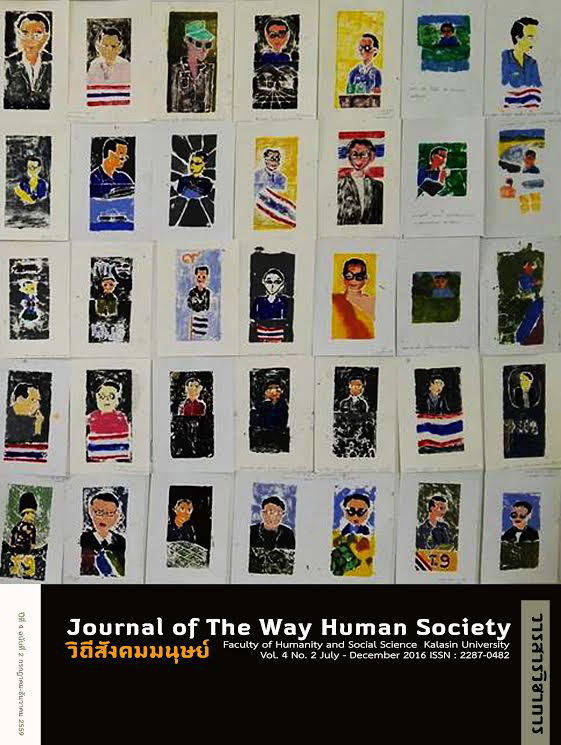งานพุทธศิลป์ฮูปแก้วสี เมืองมรดกโลกหลวงพระบาง
คำสำคัญ:
นิทานคำสอน, พุทธศิลป์ฮูปแก้วสี, เมืองหลวงพระบาง, Fable, Mural Painting Glass Buddhist Artบทคัดย่อ
การศึกษางานพุทธศิลป์ฮูปแก้วสีเมืองมรดกโลกหลวงพระบาง มีความมุ่งหมายการศึกษาถึง ความหมายงานพุทธศิลป์ฮูปแก้วสีเมืองมรดกโลกหลวงพระบาง โดยการศึกษานี้เป็นการศึกษาเชิงคุณภาพโดยใช้กลุ่มเป้าหมายฮูปแก้วสีในวัดเชียงทองเมืองมรดกโลกหลวงพระบาง ตำนานขุนลอ ผู้สร้างเมืองชวา กษัตริย์พระองค์แรกของอาณาจักรล้านช้างคือพระเจ้าฟ้างุ้ม ทั้งนี้พระเจ้าโพธิสารราช และพระเจ้าไชยเชษฐาธิราช ได้ทนุบำรุงพุทธศาสนาให้มีความเจริญรุ่งเรืองเป็นอย่างยิ่งเพราะพระองค์ทรงสร้างวัดเชียงทอง ความหมายของฮูปแก้วสีพบว่าการตีความหมายภาพผลงานฮูปแก้วสีที่สกุลช่างได้ถ่ายทอดเป็นภาพเล่าเรื่อง เป็นนิทานคำสอน ที่สกุลช่างได้ถ่ายทอดในผนังวิหารต้นทองใหญ่และนิทานคำสอนเรื่องพรานป่า โดยมีความมุ่งหมายการสอนธรรมแก่ผู้ไม่รู้หนังสือหรือสังคมพุทธสัญญะภาพเล่าเรื่องนี้จะเป็นแนวทางแก่สังคมให้ประกอบการทำความดีละเว้นการทำบาปฮูปต้นทองแก้วสีขนาดใหญ่และนิทาน พื้นบ้านเรื่องนายพรานป่าได้สอนถึงความสามัคคีการอยู่ร่วมกันของสังคม นิทานชาดกพื้นบ้านเรื่องช้างในวิหารน้อยสอนการอยู่ร่วมในสภาพแวดล้อมที่ดีและไม่ดี ฮูปแก้วสีนิทานชาดกพื้นบ้านเรื่องนกแขกเต้าสองพี่น้องสอนถึงการอยู่ร่วมกันในสังคมและสภาพแวดล้อมที่มีความแตกต่าง นิทานคำสอนฮูปแก้วสีเรื่องพระแก่กับแม่วัวสอนเรื่องกรรมตามสนอง ฮูปแก้วสีหอไหว้พระพุทธไสยาสน์ ฮูปแก้วสีเรื่องความกตัญญูสอนเรื่องหลงผิดและความกตัญญู เมื่อพิจารณาดูนิทานพื้นบ้านทั้งหกเรื่องที่กล่าวมา ได้สะท้อนถึงผู้แต่งในด้านความสามารถ เป็นกวีปราชญ์ที่ได้รับการยอมรับท่านหนึ่งในเมืองหลวงพระบางเป็นผู้ที่เข้าใจและหลักความดีงามเพื่อสั่งสอนสังคมในหลวงพระบาง ประเด็นที่สำคัญคือความมีภูมิปัญญาของสกุลช่างที่นำวัสดุแก้วสีต่างๆนำมาตัดให้เกิดเป็นภาพต่างๆตามเนื้อเรื่องที่กวีปราชญ์แต่งประพันธ์ไว้ ประกอบเป็นภาพเล่าเรื่อง ซึ่งมีตัวละครที่สกุลช่างจินตนาการเป็นภาพเล่าเรื่องที่มีนัยแฝงโดยสร้างองค์ประกอบอย่างง่ายมองด้วยระดับสายตาจากธรรมชาติ ซึ่งสอดคล้องกับทฤษฎีสัญญะมายาคติในความหมายตรงของ Roland Barthes (ค.ศ. 1915 – 1980) อาทิเช่นในภาพเล่าเรื่องกวางได้ติดกับดักบ่วงมีเต่ากำลังช่วยเหลือโดยการกัดบ่วง ซึ่งสามารถมองเห็นและรับรู้จากความหมายตรงในระดับความเป็นจริงในธรรมชาติโดยรับรู้โดยง่าย ทั้งนี้อีกนัยหนึ่ง Roland Barsthes ยังกล่าวไว้ซึ่งมีความหมายแฝงเร้นคือในสัญญะมายาคติที่เป็นสัญลักษณ์ให้สังคมมนุษย์เมืองหลวงพระบางได้เห็นและเป็นข้อคิดด้วยความหมายใหม่เป็นนามธรรม คือความสามัคคี การช่วยเหลือเกื้อกูล การทำความดีการไม่เบียดเบียนซึ่งกันและกัน สังคมจะได้สงบสุขคือความหมายที่เป็นเนื้อหาแฝงแนวคิดของหลักการทำความดีThe research aims to study the meaning of Glass Mural Painting as Buddhist Art at the Luang Prabang World Heritage site. This study is a qualitative research that uses the Glass mural paintings of Buddhist art at the Chaiangthong temple in Luang Prabang, Loas as the samples. The legend is of Khun Lo, the founder of Java, who was the first king of the kingdom Lan Chang. As a result of his reign and his building of the Chiang Thong temple, Prajao Pimpisan and Prajao Chiyachettha maintained and preserved the success of Buddhism. Glass mural painting art work in which artists use pictures covey to tell a story in fables. These mural paintings were on the wall of the vihara, or the Buddhist assembly hall called Ton Thong Yai, and the fable painting on this wall depicts a hunter. The purpose of this fable’s mural painting is to teach morality to people who did not have knowledge of Buddhist practices. This picture tells the story to guide the society to good deeds and to abstain from sin. Ton Thong Yai, the large golden colored glass tree and the folk tale of the hunter teaches the harmony of social coexistence. Likewise, jataka stories about an elephant in a small temple teach about living in good and bad environments.
Glass mural paintings of jataka stories about Khak Tao, bird brother,s teach about living in a different society and environment. The mural of a fable called A monk and a mother’s cow teaches us that ‘what goes around comes around’. Art at the Reclining Buddha temple and the story of gratitude teach about delusion and gratitude.
These six tales are written as poems and reflect on the authors in terms of ability and acceptance in Luang Prabang. The authors understood morality and the principles of goodness to teach people in Luang Prabang society. Also important was the wisdom of the artists that brought various colored glass pieces to create art work by cutting these glass pieces into different pictures according to the story that the poets wrote.
These color glass pictures depicted stories. The artists created characters from their imagination which were simple and visible with natural vision. This corresponds to the theory of mythology proposed by Barthes (1915 – 1980). For example, pictures in the story of a deer trapped by a snare and rescued by a turtle biting the snare can be seen and understood from the meaning on a natural level by simple perception.
However, Barsthes ((1915 – 1980) stated that there is also a hidden meaning that symbolizes the human society of Luang Prabang, so the murals can be seen as abstract moral lessons of harmony, support for others, doing good deeds and not encroaching on others. Hence, the murals symbolize making a peaceful society by the conceptual content of the principle of good deeds.


